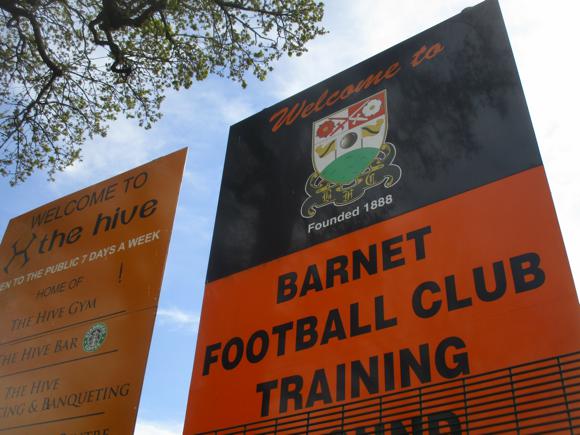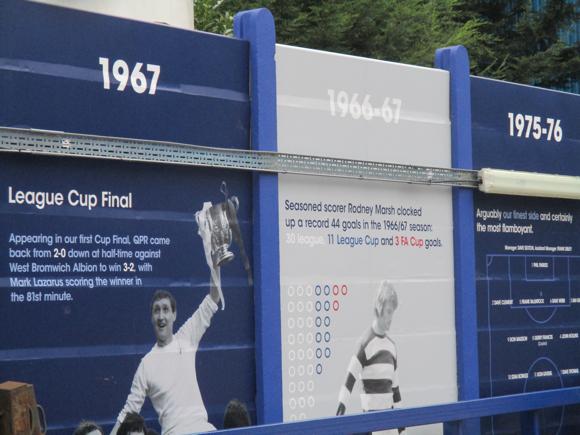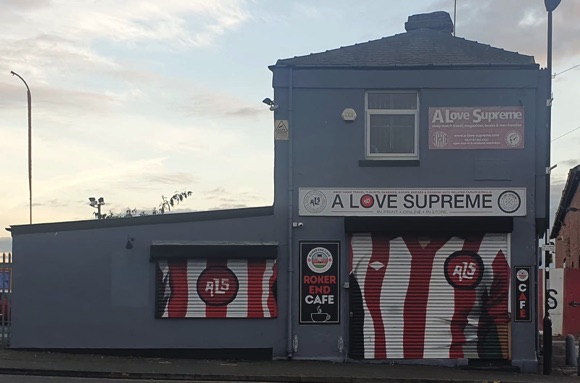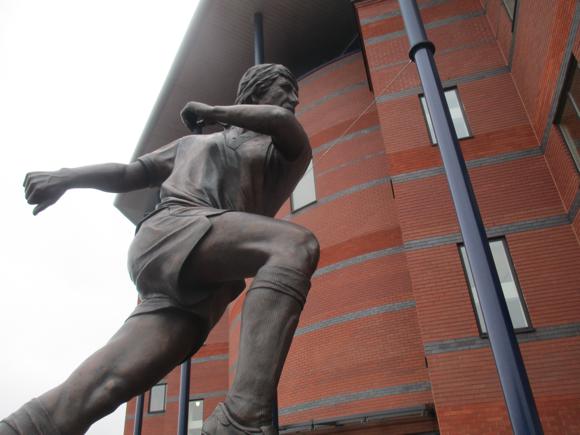A fan’s guide – the club from early doors to today
When the celebrated Class of ’92 took over Salford City in the summer of 2014, the club had just finished mid-table in the seventh-tier Northern Premier League Division One North and attracted average gates of 139. Five years and four promotions later, the Ammies entered the promised land of the Football League, before crowds at Moor Lane 18 times bigger than pre-takeover.
Then again, success has always surrounded the six alumni who played for Manchester United in two successive Youth Cup finals in 1992 and 1993 then formed the core of the treble-winning side of 1999. The Neville brothers, Ryan Giggs, Nicky Butt and Paul Scholes, later joined by David Beckham, with significant backing from Singaporean magnate Peter Lim, have again been at the right place at the right time.
The place is no coincidence. Close to The Cliff, the United training ground where the gang of six first bonded, Moor Lane is in Kersal, site of a famous racecourse in the 1800s, and borders Broughton, whose famous ex-residents include half of Joy Division/New Order, film director Mike Leigh and folk singer Ewan MacColl.

It is MacColl’s most famous song, Dirty Old Town, a tale of Salford interpreted by the Pogues, that provides the pre-match music at Moor Lane, home of the former Salford Amateurs since it opened in 1978.
The Ammies started out as Salford Central Mission in 1940, rising from district to city to county level before joining the North West Counties League when it was created in 1982. The name Salford City has remained in place since 1989, though the club badge, the municipal coat of arms, was later replaced by a ship-shaped cut-out of a lion’s head.
The colour change from tangerine to Red-Devil red insisted upon by the current ownership caused further murmurs of discontent, even unfavourable comparisons with capricious Vincent Tan. While the controversial Cardiff owner eventually deigned to reintroduce blue, Salford City still wear red – the tangerine shirts had been borrowed from Blackpool, anyway, when the club was short of cash.

With three national divisions created at the top of the non-league pyramid in 2004, semi-pro Salford aimed high after old boy Darren Quick took over the club shortly afterwards. High-profile derbies with MU phoenix club FC United of Manchester and Curzon Ashton, plus a serious promotion challenge, attracted record crowds in 2006-07, but Salford would have to wait another season to follow their local rivals out of the North West Counties League.
The step up to the Northern Premier proved memorable, Salford’s escape from relegation probably the most precarious in football history. Winning one game in 26, and taking their first three points at Moor Lane in late March, the Ammies secured survival on the last day of the 2008-09 campaign, having conceded 107 goals 40 games, 37 of them rooted to the bottom of the table. The feat galvanised the team, Quick filling in on managerial duties the following season.
Under Rhodri Giggs, brother of Ryan, and ex-Oldham midfielder Darren Sheridan, the Ammies then held their own in the Northern Premier Division One North. Despite rare windfalls – the FA Cup tie with FC United of Manchester attracted 1,300-plus in 2012 – money was always tight. Quick left club treasurer Karen Baird in charge before the Class of ’92 started sniffing around.

The ex-United stars first did what they knew best – play football. After a showcase friendly to announce their arrival, and keeping Baird in charge, as she is today, the illustrious new ownership steered Salford to the divisional title in their first season. As if scripted – the Class of ’92 story was the focus of a two-part BBC documentary – the subsequent run in the FA Cup brought further revenue, the three gripping games with Notts County and Hartlepool making great TV.
Excitement levels hit the roof with the promotional play-offs in April 2016, two late goals edging games against Ashton United and Workington, both played at a lively Moor Lane.
By now Salford were in the dizzy heights of the National League North, the Class of ’92 within sight of The 92. Knocking down all four stands at Moor Lane to build new ones, increasing capacity to 5,100, nearly half seated, the club turned professional as the National League beckoned. This time, though, the scriptwriters hadn’t reckoned on penalties, Halifax converting three of their four, Salford missing all theirs, after two heart-stopping play-off games.

No play-off was required in 2018 as Salford sailed into the National League in top spot, controversially spending big the following pre-season with promotion to the promised land of the Football League in mind. Signing ex-U21 Ireland striker Adam Rooney from Aberdeen and bringing former Scottish international Graham Alexander as manager, Salford received another boost when David Beckham came on board as co-owner halfway through the 2018-19 campaign.
Battling disgruntled poorer promotion challengers but trailing Leyton Orient in a tense title race, Salford again took a play-off tie to penalties, a successful shoot-out paving the way to Wembley. Witnessed by Beckham and the boys, plus a crowd of 8,000, the Ammies dispatched Fylde 3-0 in the play-off final, victory sealed by Gambian international left-back Ibou Touray.
Rooney continued scoring into 2019-20 as Salford regularly drew 3,000-plus crowds to Moor Lane, their League Cup debut against Leeds a near full house. A run of draws kept the Ammies mid-table when the season was cut short.
Balancing the books by offloading several key members of the 2019 promotion side, Salford replaced Graham Alexander with their former midfielder Richie Wellens as a play-off place loomed nearer but proved equally elusive in 2020-21






ground Guide
The field of dreams – and the story behind it






Surrounded by greenery and sought-after properties a world away from the gasworks walls of MacColl legend,
Moor Lane was transformed over the course of 2017. Officially known by its sponsor’s name of the Peninsula Stadium, the ground comprises four covered stands. The West Terrace for home fans and East Terrace for visiting supporters standing behind each goal are both pretty rowdy, with a row of food, drink and merchandise outlets at the Salford end.
Seating runs along each sideline, executive boxes lining the main Nevile Road South Stand. In the Moor Lane Stand opposite, visiting supporters are also allocated 200 seats nearest the away end, these sections segregated and accessed by the block A turnstile on Moor Lane. Despite Salford’s stated ambitions to be in the Championship by 2030, for all its recent overhaul Moor Lane remains charmingly modest, its 5,100 capacity dwarfed four or five times by most grounds in the current second tier.
getting here
Going to the ground – tips and timings

The quickest way from town is to take bus X43 from stop EZ in Chorlton Street a 7-8min walk from Piccadilly station, to Moor Lane, 20mins away. Walk back down Bury New Road to the junction with Moor Lane, then turn right, towards the away side of the ground. Allow 5-6mins. Buses run every 15mins. Heading back into town, the stop is across Bury New Road, opposite the Hazeldean Hotel.
Alternatively, from outside Victoria Station (stop NY), near the National Football Museum, buses 97 and 98 (every 30mins) run to and back from the same stops in Kensal, journey time 25mins. For evening games, the X43 and No.98 are the best later options. From stop NY near Victoria, bus 93 runs to Kersal Vale, to the other end of Moor Lane, a slightly further walk to the ground.
The sat nav code for Moor Lane is M7 3PZ. Around the ground, it’s permit parking only, though get here early enough and you might find a free space on Moor Lane. The club operates a P+R service from the Agecroft Industrial Estate (M27 8SJ), £2 per car. A Swans Travel bus shuttles the 5mins to/from the stadium.
getting in
Buying tickets – when, where, how and how much

The club sells tickets online and at the turnstiles on Nevile Road on match days from about 90mins before kick-off, though availability can be limited. Check with tickets@salfordcityfc.co.uk.
Admission is £10 across the board, discounts £5 for under-16s, students and seniors, generously set at over-60. Under-5s free get in free.
what to buy
Shirts, kits, merchandise and gifts

On match days, the nearest hut to the Moor Lane Stand in the row of outlets behind the home West Terrace sells merchandise. For 2020-21, home shirts are plain red, without other cuff or collar colours, away tops white with black trim, third kit black with red trim. Leisurewear is striking red and black.
Where to Drink
Pre-match beers for fans and casual visitors


A bit of a stretch a 15min walk away or two bus stops from Moor Lane at Northumberland Street, but the Star Inn is well worth the trek. Alongside a parade of shops where Bury New Road meets Northumberland Street, a path leads to Great Clowes Street. Turn left, then right into Black Hope Street. There, a cottage dating back to the 1840s, a pub since 1856, now operates as an urban co-operative, an independent gem of three rooms and a beer garden.
A rotating range of real ales lines the counter as you enter, leading to a larger space with a big TV showing live action, then a pool room with another TV. A jukebox, dartboard, friendly staff and free live music complete the picture.




The quieter pre-match alternative, two bus stops the other side of the stadium from town, is the bar at the Fairways Lodge hotel on George Street. Either alight at Kings Road or walk up Bury New Road, past the turning for Moor Lane, for 10-15mins, then turn into George Street at Sainsbury’s.
At the ground, behind the West Terrace, home fans enjoy a wide choice of beer from Salford’s Seven Bro7hers brewery, and sausages by traditional, Bury-based Grandad’s.







































































































